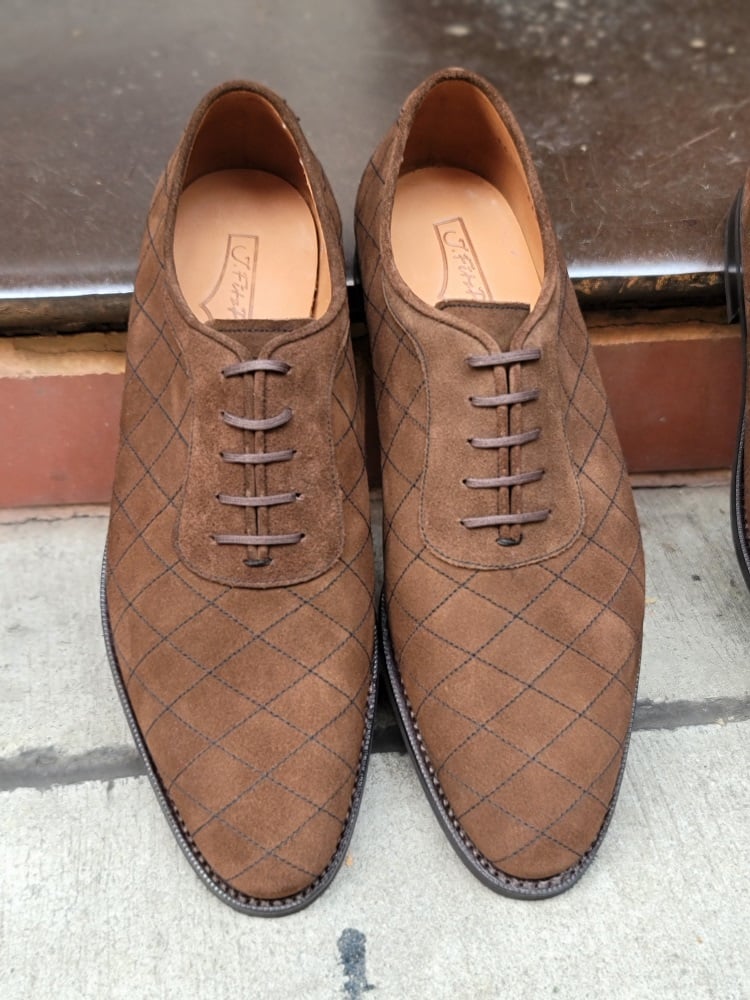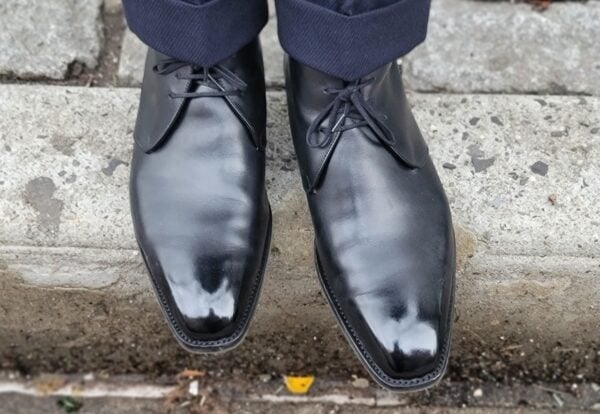Like most leathers, suede can be complex, inconsistent, and vary greatly from hide to hide. Let us take look at a very simple example of this with two pairs of shoes cut in the same size, in the same suede, in the same model. For the purposes of this post, we will be solely discussing split suede from Charles F Stead, of England. To learn more about the terminology of split suede vs full-grain suede please read this great article by my pal Jesper of Shoegazing.
Upon matching pairs from my latest sample sale when taking down my display, I found how 2 pairs varied significantly in terms of how the suede looked, from its texture, and even the color to the mixing and matching of pieces to make up the upper. While it was not so surprising as I have been at this a while, I finally had a great example to highlight this issue, which will exist for many shoemakers within the industry.
While shoemakers hold responsibility for how their shoes look, a lot of the issues actually stem at the tannery and it is not always so easy to get around these issues unless you are a very big company with a lot of weight behind your wallet. You think I am exaggerating this but it is a real problem, one too, that has been getting worse over the years as big conglomerates buy up all of the top grade leathers and the small shoemakers get hit with the scraps.
The issue of the split suede is that when they make a hundred hides, those hides are not consistent throughout and for various reasons. If you read Jesper’s article, you know that they will split the hide to create two (or even three) layers of the hide. Those layers will not be the same consistency of the nap and because of that, I imagine through deduction, that during the tanning process if there is a difference, that the hides will absorb the color differently, thus getting a pair light (the pair with less nap, more like nubuck) and a darker pair (the one with more nap and ability to thus absorb dye). However, if they are tanning the hide first all the way through and then splitting it, then it makes even more sense for the end pieces to be darker while the inner piece less dark. Either way, you can see that from the same article of suede, comes two very different cuts and looks.

One pair had a short nap and a lighter color. The other, a longer nap and darker color. But even more interesting (frustrating) is the fact that the adelaide pieces were then mixed up and both pairs had a piece from each hide, causing even more inconsistency. And this is where the fault of the factory lies, namely the clickers and/or closers that put the pieces together not doing their best to make sure it all matches from the left side to the right side. And truth be told, this is what you pay for when not buying +$600 shoes.
You may think that sounds crazy but the more time spent on shoes the more they cost. And time is every second of the process. So, the more they spend ensuring 100% consistency, the most expensive they are. That is really why Italian, blake stitch shoes will often cost as much as welted ones, if not more. It’s not because blake stitch shoes are expensive. It is because the Italians are the kings of consistency. But that consistency costs money. And the Spanish, unfortunately, have the most room for improvement. But I think that they prefer to offer value for money rather than 100% consistency.
So the problem starts at the tannery and ends up at the factory. Big factories producing lower to mid-tier welted shoes and large quantities are not going to sift through all of the hides and ensure one client’s production run is cut from only exact-looking hides. It just doesn’t work like that. They will simply grab the first ones available and cut all of the leather, hence getting two pairs that look like the one’s featured here. And this is not a complaint from me, because the reality is that I cannot expect more at the price that I pay. It is the smaller (or more serious, think C&J or EG) factories that tend to examine and thoroughly choose the leather/hides to make a line with, and as I have spoken on many times, create much more wastage which ultimately translates to the final price of the shoe to the customer.
The question one will immediately pose is ‘why not use full-grain suede, then’? Still assuming the same tannery used, let’s discuss the answers, below:
- Full-grain usede is super expensive. Even more so than the most expensive calfskin. And while that is not necessarily a problem, the problem is its value for money. I used the Janus suede for a winter collection and found more problems than in repello. The suede had cuts (most likely veins perceived as cuts) all over the hides and when making the shoes, these cuts really stood out. And they stood out more so because the nap was longer. So you pay double and get more problems. That is bad business.
- The colors offered are not the same. For me they had less luster. For example, the dark brown suede in Janus calf has more grey tones behind it, whereas the dark brown suede in repello has more reddish/yellowish undertones. There are gives and takes here, as the Janus calf has Fox suede which is very nice, but the suedes I personally utilized most were not the same and not as attractive in the Janus calf
- The nap is longer and more beautiful but harder to maintain. Because it is longer and more illustrious it shows its wear & tear a lot more than the repello does. So you have maintain it way more and often it is not as easy to rejuvenate. So, if you pay more for it, the colors are less vibrant (not all) and it does not wear as well in terms of being hard on it, then why spend so much on a product that is way more delicate? I guess it’s cool if you are going from house to car, to a/c controlled environment and never seeing the light of day or harsh weather. Sure, then by all means, go for Janus (or equivalent) only.
Personally speaking, it has been my plan to upgrade to a full-grain suede, maybe out of Italy, as again, I was disappointed greatly with Janus calf. But I will always love repello as a hard-wearing and well-priced suede that, for me, looks good, lasts long, and is easy to upkeep. The inconsistency issues at the end of the day, are a part of the struggles of being a shoe brand. It just is what it is. But, to all of you, know this is the case for all brands using split suedes. They won’t always be the exact same from pair to pair. That is the reality.
I hope that you all have enjoyed this point on suede and the differences you can find in it.
















Very insightful, Justin. Thank you
Thanks Jim and my pleasure, glad that you enjoyed it!
Really enjoyed this post. Nothing beats insight and common sense gained through experience! It all helps to get past the marketing spin applied to various brands and grades.
Thank you Scott, I am glad that you enjoyed it and I appreciate you saying so
Dear Justin,
This is yet another of your articulated work where you describe the complicated in the most simplistic way, so that the average reader can make sense of and understand not just subject but about the background as well.
Well done, and thank you for your great efforts.
We are always waiting for you to share your immense knowledge and wisdom, so that we are even better able to appreciate about it all, the shoes.
Regards,
Nadeem – Sharjah.
Thank you very much for your comment and kind words Nadeem, I do very much appreciate your support!
Cudos, another great article, Justin. Fantastic inside look into the business. You write and speak directly from the heart. Highly appreciated.
Thank you very much, I do appreciate it and your support. It means a lot
Hi Justin,
I have a question about the fit of Box calf vs. suede; if you have two identical “for example” Chelsea boots (size, last and so on) in those materials, is it normal that the suede one feels more loose on the foot and the Box calf more tight?
Thanks for your advice!
Niko
Hey Niko, yes it is normal. Suede does not often form the same way that calfskin does and therefore feels looser even everything is exactly the same. This is especially true in non-handmade shoes. In handmade shoes, truly handmade, they will feel more similar.